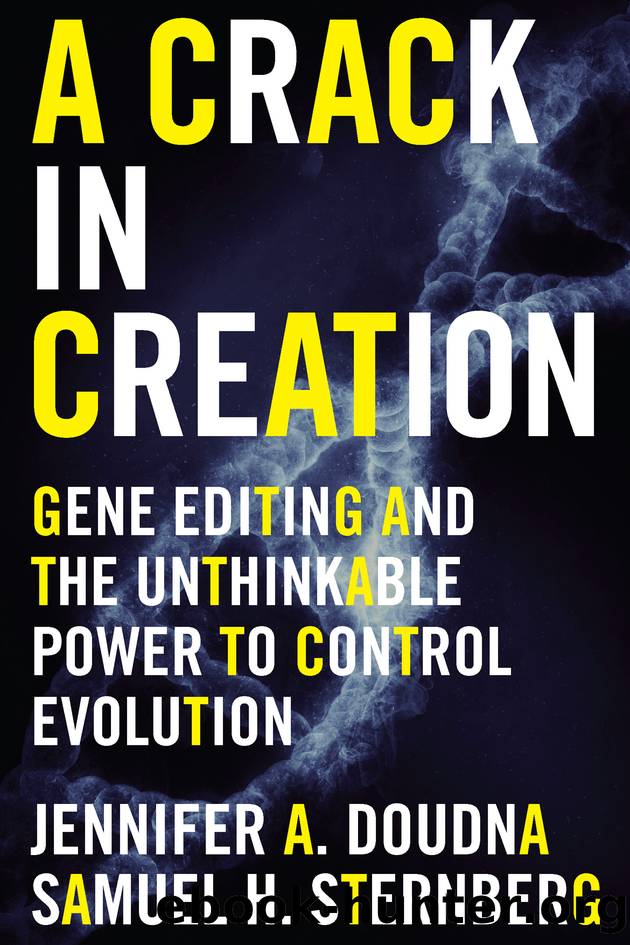Crack in Creation : Gene Editing and the Unthinkable Power to Control Evolution (9780544716964) by Doudna Jennifer A.; Sternberg Samuel H

Author:Doudna, Jennifer A.; Sternberg, Samuel H.
Language: eng
Format: epub
Publisher: Houghton Mifflin
There is one way, at least, in which the power to edit the genes of other species could prove to be more dangerous than any changes humans have made to the planet so far. I’m referring to a revolutionary technology known as a gene drive, so called because it gives bioengineers a way to “drive” new genes—along with their associated traits—into wild populations at unprecedented speeds, a kind of unstoppable, cascading chain reaction.
With gene drives, as with other developments in the burgeoning gene-editing field, the science has moved so fast that it’s hard to keep up. Just a year after it was first proposed in a theory paper, CRISPR gene drives proved effective, first in fruit flies and then in mosquitoes. These gene drives harness the power of a special type of inheritance pattern, one that defies the normal way genetic information is shared between generations of living things.
In normal sexual reproduction between species that contain two copies of each chromosome, offspring acquire just one chromosome copy from each parent, meaning that any particular gene variant has a 50 percent probability of being inherited. However, there are certain DNA sequences, called selfish genes, that can increase their frequency in the genome with each generation, even without conferring any fitness advantage on the offspring. In 2003, evolutionary biologist Austin Burt proposed a way to harness selfish genes in order to spread novel traits more efficiently and to ensure that offspring would have a 100 percent probability of inheriting a given segment of DNA. But his idea hinged on a technology that didn’t really exist at the time: easily programmable DNA-cutting enzymes that would allow for simple gene editing.
Enter CRISPR. In the summer of 2014, George Church’s team at Harvard, led by Kevin Esvelt, proposed a way to design and build gene drives with the help of efficient gene editing. In essence, the idea relies on a gene knock-in approach, in which scientists use CRISPR to cut DNA at an exact location and insert a new sequence of letters into the breach. There is one major difference with a gene drive, however: part of the new DNA added in contains the genetic information that encodes CRISPR itself. Like that sci-fi trope of a self-replicating machine, a CRISPR gene drive can autonomously copy itself into new chromosomes, allowing it to grow exponentially within a population. By combining CRISPR with various genetic payloads, such as pathogen-resistance genes, Esvelt theorized, scientists could program CRISPR to copy not only itself, but any other desirable DNA sequences.
As it turns out, gene drives can be as remarkably effective as the theory predicts. In early 2015, Ethan Bier and his student Valentino Gantz at UC San Diego reported the first successful demonstration of a CRISPR gene drive in the common fruit fly, using it to drive a defective pigmentation gene into the genome. The result: 97 percent of the edited flies were a new, light yellow color instead of the species’ usual yellow-brown. Within half a year, the same
Download
This site does not store any files on its server. We only index and link to content provided by other sites. Please contact the content providers to delete copyright contents if any and email us, we'll remove relevant links or contents immediately.
The Light of Days by Judy Batalion(828)
The Crime Book by DK(703)
Chasing the Thrill by Daniel Barbarisi(653)
1312, Among the Ultras by James Montague(585)
The Doctor Who Fooled the World by Brian Deer(565)
Till Murder Do Us Part by James Patterson(558)
Invention by James Dyson(557)
E.R. Nurses by James Patterson(557)
The Complete Correspondence 1928-1940 by Theodor W. Adorno & Walter Benjamin(503)
Climb by Susan Spann(487)
Mind Games by Neville Southall(478)
The Dream Architects by David Polfeldt(474)
Space 2069 by David Whitehouse(473)
The Reporter by Mark Paul Smith(472)
Surely you Ìre joking, Mr Feynman by Richard Feynman(457)
If You Should Fail by Joe Moran(441)
Masterful Marks: Cartoonists Who Changed the World by Monte Beauchamp(429)
The 'Wolfman' by Sigmund Freud & Sigmund Freud(427)
Banking and Beyond by Unknown(421)
